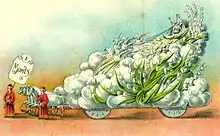Knights of Momus
The Knights of Momus ("KOM") were a Mardi Gras society in Galveston, Texas, founded in 1871.[1] The original Knights of Momus went defunct around the time of World War II. A new group was founded in the mid-1980s, and seeking to rekindle the spirit of the original group, adopted the Momus name. The group was named after the Greek god Momus.
| Abbreviation | KOM |
|---|---|
| Named after | Momus |
| Motto | dum vivimus vivamus |
| Formation | 1871 |
| Founded at | New Orleans, LA. |
| Type | Carnival Krewe |
| Location |
|

"The Knights of Momus" is also the name of the second-oldest krewe in the New Orleans Mardi Gras, which was founded in 1872. Unlike the Galveston Momus organization, the New Orleans iteration of the Knights of Momus has operated continuously since its founding, and remains true to its roots as a secret society.
For over 100 years, the Momus parade was a fixture of the New Orleans Mardi Gras parade schedule, parading annually on the Thursday before Fat Tuesday. Since Momus was the Greek god of mockery, the themes of Momus parades typically paid homage to the organization's namesake with irreverent humor and biting satire. The 1877 parade theme, "Hades, A Dream of Momus," caused an uproar when it took aim at the Reconstruction government established in New Orleans after the Civil War. Attempts at retribution by local authorities were largely unsuccessful due to the secrecy of the membership.
In 1991, the New Orleans City Council passed an ordinance that required social organizations, including Mardi Gras Krewes, to certify publicly that they did not discriminate on the basis of race, religion, gender or sexual orientation, in order to obtain parade permits and other public licensure. In effect, the ordinance required these, and other, private social groups to abandon their traditional code of secrecy and identify their members for the city's Human Relations Commission. Momus was one of three historic krewes (with Comus of 1857 and Proteus of 1882) that withdrew from parading rather than identify their membership (Proteus resumed parading in 2000).[2]
Two federal courts later declared that the ordinance was an unconstitutional infringement on First Amendment rights of free association, and an unwarranted intrusion on the privacy of the groups subject to the ordinance.[3] The Supreme Court refused to hear the city's appeal from this decision. Nevertheless, the Momus parade never returned to the streets of New Orleans, although the group still conducts an annual bal masqué on the Thursday before Mardi Gras.
References
- Kearney, Sid (30 January 2014). "Make the most out of your trip to Galveston for Mardi Gras". Houston Chronicle. Retrieved 21 November 2014.
- Nolan, Bruce (12 February 2012). "Bitter Mardi Gras debate of race, class evolves 20 years later into a diverse celebration". The Times-Picayune. Retrieved 21 November 2014.
- The decision of the Fifth Circuit Court of Appeals appears at volume 42, page 1483 of the Federal Reporter (3rd Series), or 42 F.3d 1483 (5th Cir. 1995).